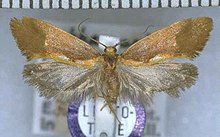| Tingena phegophylla | |
|---|---|

| |
| Male lectotype | |
| Scientific classification | |
| Domain: | Eukaryota |
| Kingdom: | Animalia |
| Phylum: | Arthropoda |
| Class: | Insecta |
| Order: | Lepidoptera |
| Family: | Oecophoridae |
| Genus: | Tingena |
| Species: | T. phegophylla |
| Binomial name | |
| Tingena phegophylla (Meyrick, 1883) | |
| Synonyms | |
| |
Tingena phegophylla is a species of moth in the family Oecophoridae. It is endemic to New Zealand and has been observed in the southern parts of the South Island. This species inhabits native beech forest. The adults of this species are on the wing in December.
Taxonomy
This species was first described by Edward Meyrick in 1883 using specimens collected at Lake Wakatipu in December and named Oecophora phegophylla. Meyrick went on to give a more detailed description in 1884. In 1915 Meyrick placed this species within the Borkhausenia genus. In 1926 Alfred Philpott was unable to study the genitalia of the male of this species as no specimens were held in New Zealand collections however Dugdale points out that the genitalia of basella agrees with the genitalia of the lectotype of T. phegophylla. George Hudson discussed and illustrated this species under the name B. phegophylla in his 1928 publication The butterflies and moths of New Zealand. In 1988 Dugdale placed this species in the genus Tingena. The male lectotype is held at the Natural History Museum, London.
Description

Meyrick first described this species as follows:
Fore wings dilated, reddish-ochreous-brown, a discal dot and indented dorsal streak ochreous-whitish, partly suffused with yellow; hind wings dark grey.
Meyrick's more detailed description is as follows:
Male.— 21-22 mm. Head ochreous-yellow. Palpi ochreous-yellow, externally mixed with dark fuscous. Antennae dark fuscous. Thorax ochreous-yellow, suffused with fuscous except on posterior margin. Abdomen grey. Legs dark fuscous, hairs of posterior tibiae and apex of all joints ochreous-yellow, beneath wholly ochreous-yellow. Forewings moderate, posteriorly strongly dilated, costa moderately arched, apex obtuse, hind-margin oblique, hardly rounded; reddish-ochreous-brown, becoming deeper towards inner margin; a minute ochreous-whitish dot in disc beyond middle; an ochreous-whitish streak along inner margin from base to 3⁄4, towards extremities suffused with bright ochreous-orange, its upper margin rather deeply indented at 1⁄3, thence somewhat dilated, and again attenuated to apex : cilia reddish-ochreous brown, beneath anal angle ochreous-whitish suffused with orange. Hindwings dark grey; cilia grey, extreme base pale.
The colouring of this species closely resembles a dead native beech leaf.
Distribution
This species is endemic to New Zealand. It has been observed in the southern parts of the South Island including its type locality of Lake Wakatipu, at Leithen Bush, and in the Routeburn Valley.
Behaviour
The adults of the species are on the wing in December.
Habitat
This species has been observed inhabiting native beech forest and have been collected off Nothofagus solandri.
References
- ^ Gordon, Dennis P., ed. (2010). New Zealand inventory of biodiversity: Kingdom animalia: chaetognatha, ecdysozoa, ichnofossils. Vol. 2. p. 462. ISBN 978-1-877257-93-3. OCLC 973607714. OL 25288394M. Wikidata Q45922947.
- ^ Dugdale , J. S. (23 September 1988). "Lepidoptera - annotated catalogue, and keys to family-group taxa". Fauna of New Zealand. 14. Department of Scientific and Industrial Research: 104. doi:10.7931/J2/FNZ.14. ISSN 0111-5383. Wikidata Q45083134.
- ^ Edward Meyrick (September 1883). "Descriptions of New Zealand Micro-Lepidoptera.—III.—Oecophoridae". New Zealand Journal of Science. 1: 524. Wikidata Q106368126.
- ^ Edward Meyrick (1884). "Descriptions of New Zealand Microlepidoptera. III. Oecophoridae". Transactions and Proceedings of the New Zealand Institute. 16: 39–40. ISSN 1176-6158. Wikidata Q63976486.
- E. Meyrick (12 July 1915). "Revision of New Zealand Tineina". Transactions and Proceedings of the New Zealand Institute. 47: 212. ISSN 1176-6158. Wikidata Q63123349.
- ^ Alfred Philpott (1926). "List of New Zealand species of Borkhausenia (Oecophoridae: Lepidoptera), including new species". Transactions and Proceedings of the New Zealand Institute. 56: 399–413. ISSN 1176-6158. Wikidata Q110157185.
- ^ Hudson, G. V. (1928), The butterflies and moths of New Zealand, Illustrator: George Hudson, Wellington: Ferguson and Osborn Limited, p. 265, LCCN 88133764, OCLC 25449322, Wikidata Q58593286
- K. J. M. Dickinson; A. F. Mark; B. I. P. Barratt; B. H. Patrick (March 1998). "Rapid ecological survey, inventory and implementation: a case study from Waikaia Ecological Region, New Zealand". Journal of the Royal Society of New Zealand. 28 (1): 83–156. doi:10.1080/03014223.1998.9517556. ISSN 0303-6758. Wikidata Q54578259.
| Taxon identifiers | |
|---|---|
| Tingena phegophylla | |